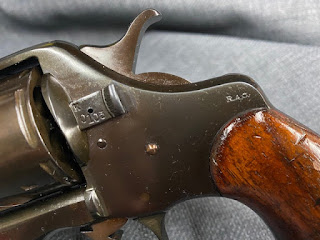Model: 56
Mfg. Date: ~1938 (pre serial requirement. Made from 1933-1945 w/97,500 total production)
Caliber: 22 short, 22 long, & 22 long rifle (can shoot any 22 still in mfg.)
Issues: Well used, but overall in good condition. The bore is clean & bright with full rifling grooves. A bore & chamber casting was taken, and the headspace checked with a "Go/No-Go" gauge - is within the SAAMI specifications. The firing pin will need to be replaced within a couple hundred rounds (simple replacement). The stock has a few superficial cracks at the butt of the stock. Oil ingress throughout, and as much as possible has be removed without destructive methods (e.g. soaking in acetone) to retain what little original finish is left. Metal parts in good shape with slight pitting, and around 80% original blued finish remains. The scope was not reinstalled. There is a fair amount of corrosion and worst, fungus within the body. Without complete disassembly, this will never be cleaned. Fully taking this apart would result in a broken scope. The age and brittleness is more than I am comfortable with. A new scope comparable to the one on the rifle can be had for under $100. I would recommend a Simmons or Weaver "classic" scope, if one is desired.
Actions: Full disassembly. Barrel/Receiver cleaned, sugar rust removed, and carded with .002" brush wheel. Action & remaining metal items boiled to convert ferrous oxide (rust) into ferric oxide (bluing), with carding to remove rust velvet. All metal items then soaked in kerosene to drive away any remaining water, and then blown out with dry compressed air, and then soaked in CLP gun oil. This acts as a preservative.
Stock work was nothing more than a cleaning to remove surface gunk and oxidized oil. After cleaning, a feeder wax was applied and then a light coat of Tung Oil was applied to give some protection. All scuffs, dents, and marks were left as is. The stock can be refinished to the factory condition with a few small areas that would be visible after (sanding them out would change the shape of the contours).
Stock work was nothing more than a cleaning to remove surface gunk and oxidized oil. After cleaning, a feeder wax was applied and then a light coat of Tung Oil was applied to give some protection. All scuffs, dents, and marks were left as is. The stock can be refinished to the factory condition with a few small areas that would be visible after (sanding them out would change the shape of the contours).
A function test was carried out on the feeding/ejection and on the safety mechanism as well as the trigger - all check out. A fire function test will be carried out Friday 9/10. Assuming the firing test results are satisfactory, the rifle can go back home and be enjoyed.
Upkeep: It is advisable to keep the rifle stored within the siliconized "sock" provided. If the rifle is going to be stored for months between firing, I recommend taking the barrel and action out of the stock and giving both a good wipe down and a light oiling on all metal surfaces (including the bore and magazine), and a light coat of stock or furniture wax before reassembly. Taking the rifle apart requires 1 screw to be un-done. This will be demonstrated upon drop off.
Before:
After
The firing pin had some mushrooming to the tip. It was lightly buffed out and polished. The first picture below is the "as disassembled" pin, and the next picture is after.






























































